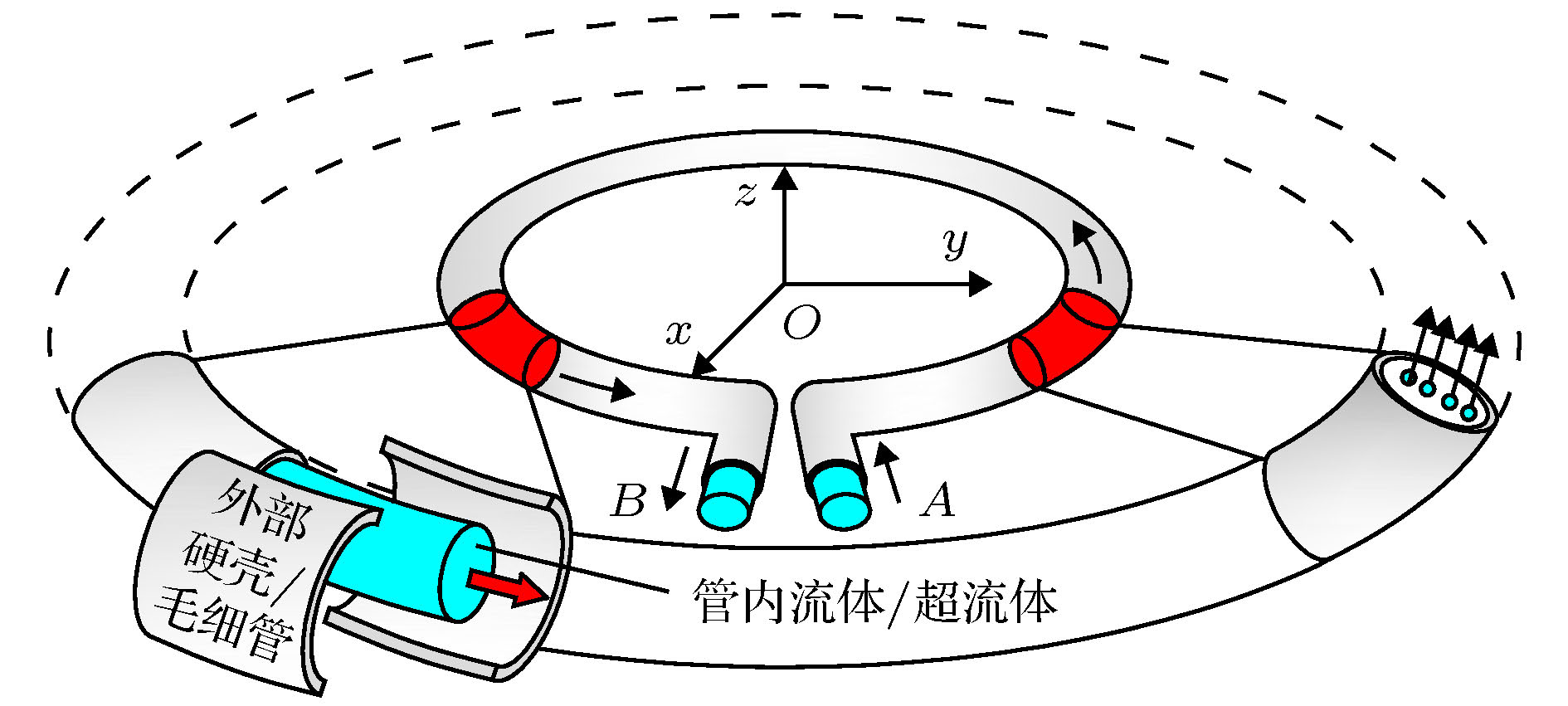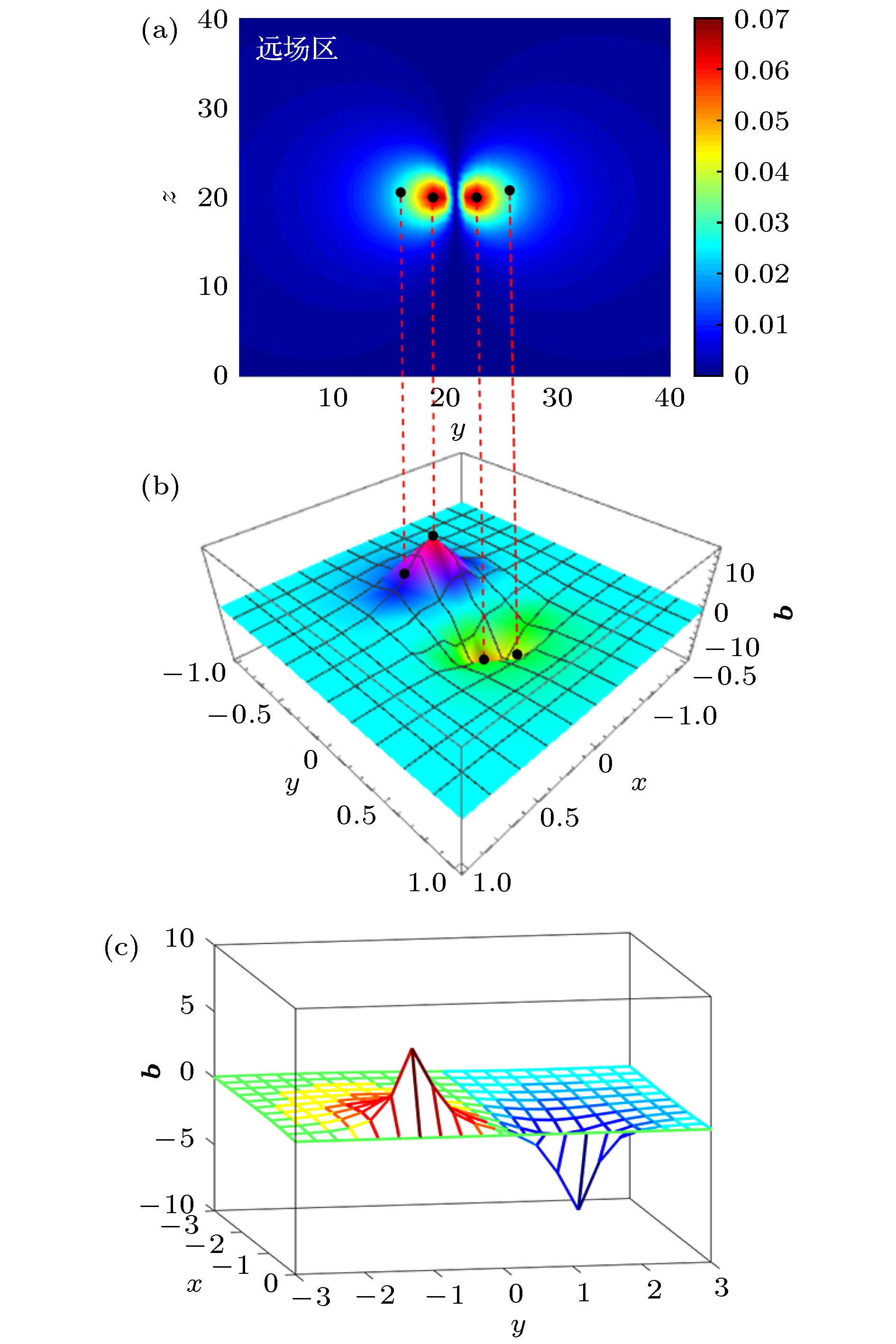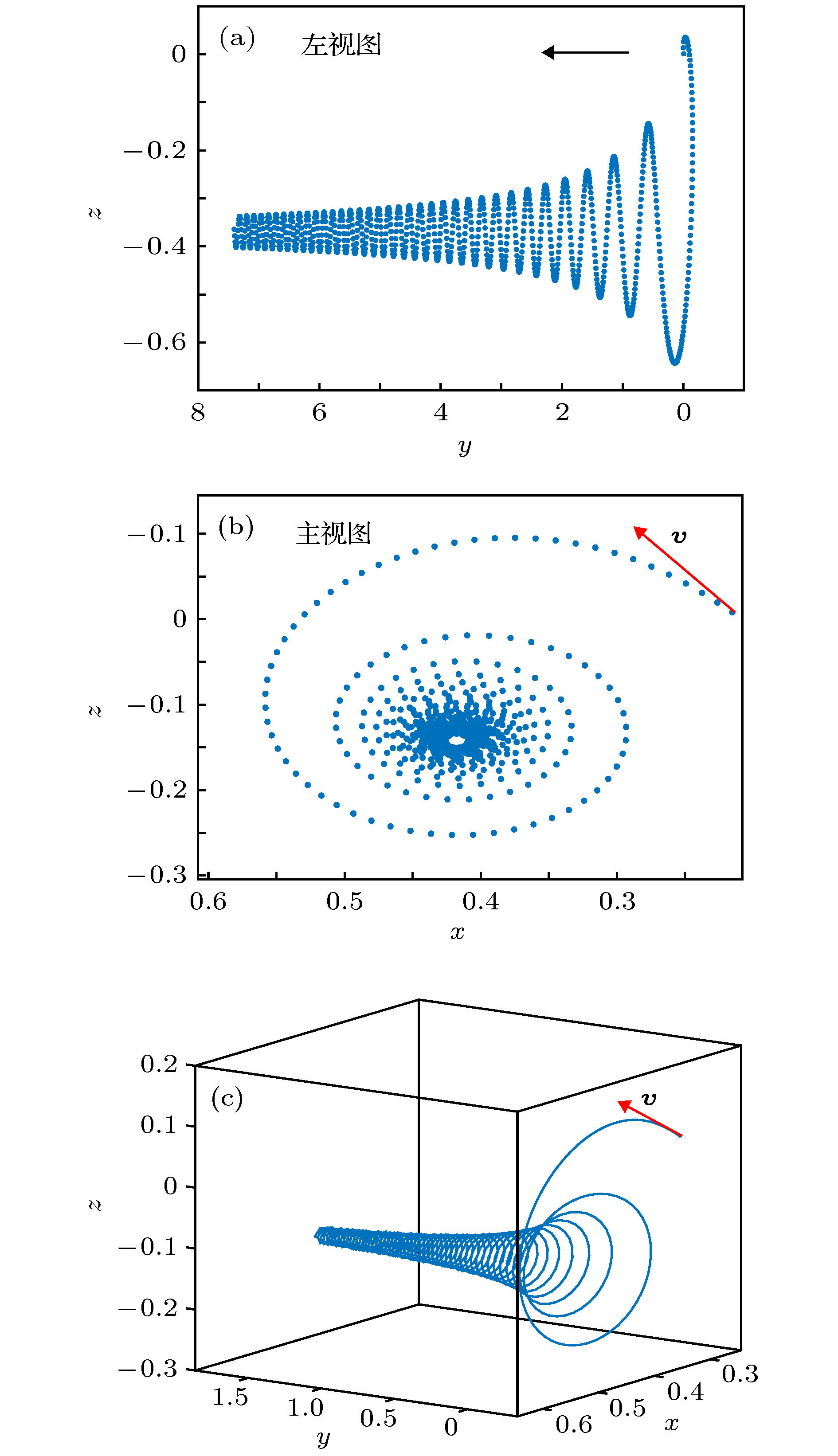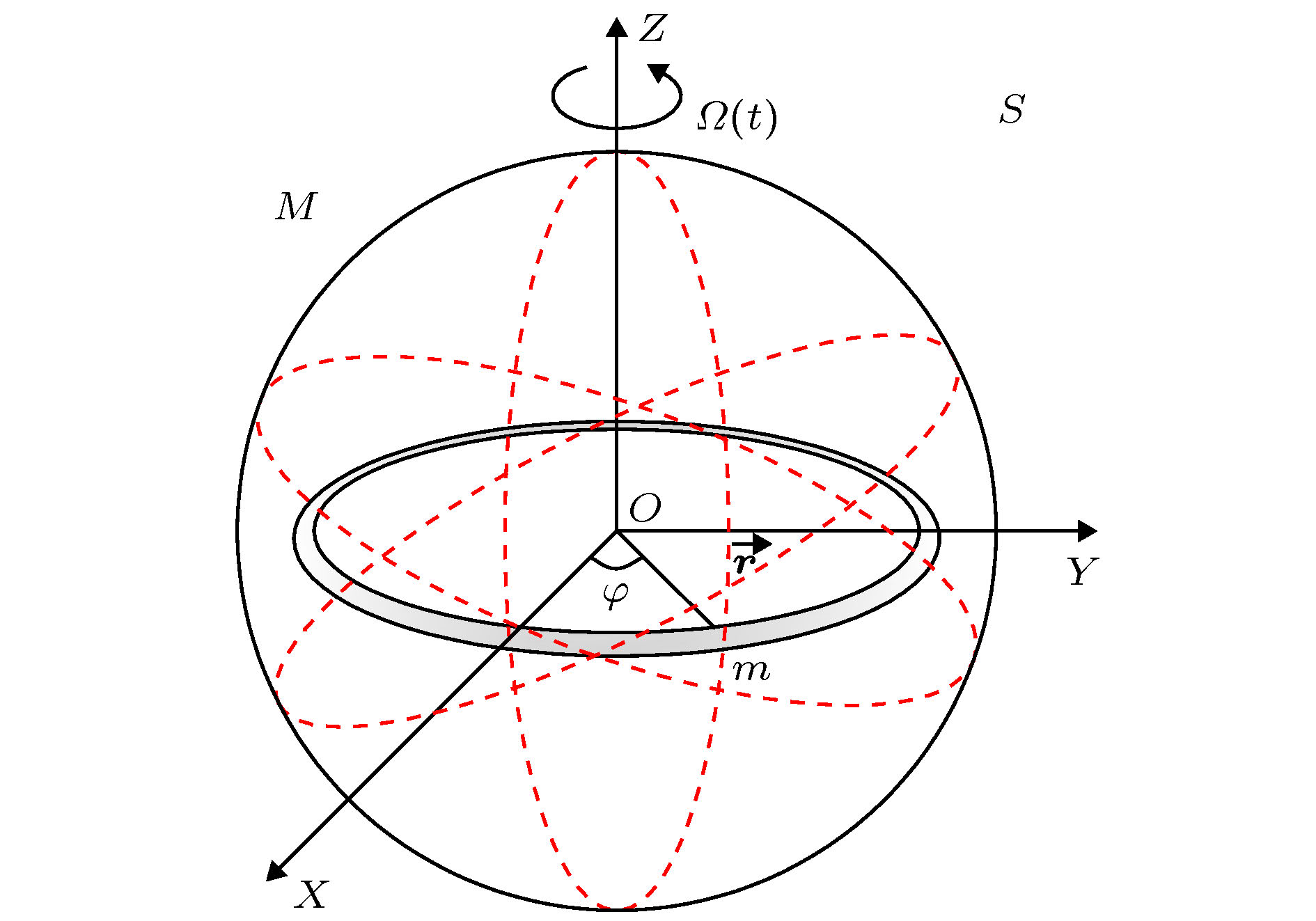-
According to the General Relativity (GR), under the approximation of the weak field, the weak gravitational field not only contains the classical Newtonian gravitational field, but also contains a gravitomagnetic (GM) field analogous to the concept of magnetic field, and the name of GM field borrows the basic idea of the magnetic field in electrodynamics. In order to study the physical properties of GM field and its associated effects, firstly, we use a similarity transformation method to decompose the gravitomagnetic component from the second-order tensor field in linearized Einstein field equation and define the concept of the GM field. Then, on this basis, we consider a circular microtube model with uniform velocity fluids (or superfluids), and study the distribution characteristics of the far GM field by this special model. We use a simpler approximation approach to improve the previous calculation method of the GM field in these kind of rings model, the result shows that the distribution characteristic of the far GM field in this model is analogous to the magnetic field produced by a dipole, it is a good correspondence between this microtube model and the dipole model. After that, we have studied the dynamic characteristics of GM field by analogizing the properties of magnetic field, and studied the test particles’ tracks in the linear time-varying GM field and the cosine time-varying GM field in the first time. In addition, in order to improve the previous research methods of ‘gravitational induction’ and ‘frame dragging’ in the GR, we have designed a circular microtube model which has a double-layer structure and with the accelerating flow fluid (or superfluids), we use simpler mathematics than before to explain these two effects by this special model. In conclusion, this work provides some new methods for the study of GM field and its associated effects.
-
Keywords:
- linearized theory of gravity /
- circular microtube model /
- gravitomagnetic field /
- gravitomagnetism
[1] Rocha F, Malheiro M, Marinho Jr R 2015 Proceedings of the MG14 Meeting on General Relativity Rome, Italy, July 12−18, 2015 p4331
[2] Ruggiero M L 2016 Astrophys. Space Sci. 361 140
 Google Scholar
Google Scholar
[3] Tajmar M, Assis A K T 2015 Can. J. Phys. 93 1571
 Google Scholar
Google Scholar
[4] Everitt C W F, DeBra D B, Parkinson B W, Turneaure J P, Conklin J W, Heifetz M I, Keiser G M, Silbergleit A S, Holmes T, Kolodziejczak J, Al-Meshari M, Mester J C, Muhlfelder B, Solomonik V G, Stahl K, Worden P W, Jr Bencze W, Buchman S, Clarke B, Al-Jadaan A, Al-Jibreen H, Li J, Lipa J A, Lockhart J M, Al-Suwaidan B, Taber M, Wang S 2011 Phys. Rev. Lett. 106 221101
 Google Scholar
Google Scholar
[5] Ciufolini I, Pavlis E C 2004 Nature 431 958
 Google Scholar
Google Scholar
[6] Iorio L 2006 Classical Quantum Gravity 23 5451
 Google Scholar
Google Scholar
[7] Iorio L 2012 Sol. Phys. 281 815
 Google Scholar
Google Scholar
[8] Tajmar M, Plesescu F, Seifert B, Marhold K 2007 AIP Conf. Proc. 880 1071
 Google Scholar
Google Scholar
[9] Mashhoon B, Iorio L, Lichtenegger H 2001 Phys. Lett. A 292 49
 Google Scholar
Google Scholar
[10] Ruggiero M L 2015 Int. J. Mod. Phys. D 24 1550060
[11] Bini D, Cherubini C, Chicone C, Mashhoon B 2008 Classical Quantum Gravity 25 225014
 Google Scholar
Google Scholar
[12] Tartaglia A, Ruggiero M L 2003 Eur. J. Phys. 25 203
 Google Scholar
Google Scholar
[13] Ruggiero M L, Tartaglia A 2002 arXiv: 0207065 [gr-qc]
[14] Wu N 2005 Commun. Theor. Phys. 44 883
 Google Scholar
Google Scholar
[15] Vető B 2011 Eur. J. Phys 32 1323
 Google Scholar
Google Scholar
[16] Mashhoon B 2008 Classical Quantum Gravity 25 085014
 Google Scholar
Google Scholar
[17] 刘辽, 赵峥 2004 广义相对论 (北京: 高等教育出版社) 第80—90页
Liu L, Zhao Z 2004 General Relativity (Beijing: Higher Education Press) pp80–90 (in Chinese)
[18] Mironov V L, Mironov S V 2014 J. Mod. Phys. 5 917
 Google Scholar
Google Scholar
[19] Demir S 2013 Int. J. Theor. Phys. 52 105
 Google Scholar
Google Scholar
[20] Mashhoon B 2003 arXiv: 0311030 [gr-qc]
[21] Clark S 2006 New Sci. 192 36
[22] De Matos C J, Tajmar M 2005 Physica C 432 167
 Google Scholar
Google Scholar
[23] Aharonov Y, Carmi G 1973 Found. Phys. 3 493
 Google Scholar
Google Scholar
[24] Overhauser A W, Colella R 1974 Phys. Rev. Lett. 33 1237
 Google Scholar
Google Scholar
[25] Arif M, Dewey M S, Greene G L, Jocobson D, Werner S 1994 Phys. Lett. A 184 154
 Google Scholar
Google Scholar
[26] Krishnan V V, Bailes M, Van Straten W, Wex W, Ferire P C C, Keane E F, Tauris T M, Rosado P A, Bhat N D R, Flynn C, Jameson A, Ostowski S 2020 Science 367 577
 Google Scholar
Google Scholar
[27] Tajmar M, De Matos C J 2003 Physica C 385 551
 Google Scholar
Google Scholar
[28] 王刚志, 郭肖勇, 吴泽华, 王晋研, 夏梦莹 2018 物理与工程 28 84
 Google Scholar
Google Scholar
Wang G Z, Guo X Y, Wu Z H, Wang J Y, Xia M Y 2018 Physics and Engineering 28 84
 Google Scholar
Google Scholar
[29] Shen J Q 2002 Gen. Relativ. Gravition 34 1423
 Google Scholar
Google Scholar
[30] Mashhoon B, Gronwald F, Theiss D S 1999 Ann. Phys. 8 135
 Google Scholar
Google Scholar
[31] Braginsky V B, Caves C M, Thorne K S 1977 Phys. Rev. D 15 2047
 Google Scholar
Google Scholar
[32] 梁灿彬, 曹周键, 陈陟陶 2018 电磁学 (拓展篇) (北京: 高等教育出版社) 第222−227页
Liang C B, Cao Z J, Chen Z T 2018 Electromagnetics (Extended) (Beijing: Higher Education Press) pp222−227 (in Chinese)
-
图 2 微管模型引力磁场远场分布特征 (a) 微管模型y-z平面沿y方向的引力磁场分布色谱图; (b) 微管模型x-y平面沿y方向的引力磁场强度分布特征图; (c) 微管模型x-y平面沿y方向上引力磁场强度随y坐标轴的变化曲线
Figure 2. The far-field distribution of GM field in the microtube model: (a) The intensity plots of GM field's along y-direction in y-z plane of microtube model; (b) the distribution of GM field's along y-direction in x-y plane of microtube model; (c) the b-y function along y-direction in x-y plane of microtube model.
图 3 模式一下测试粒子的运动轨迹 (a) 测试粒子在线性时变引力磁场中运动轨迹的左视图; (b) 测试粒子在线性时变引力磁场中运动轨迹的主视图; (c) 测试粒子在线性时变引力磁场中的全空间运动轨迹
Figure 3. The test-particle's track in linear time-varying GM field: (a) The left view of the test-particle's track; (b) the main view of the test-particle's track; (c) the test-particle's track in the whole space.
图 4 模式二下测试粒子的运动轨迹 (a) 测试粒子在余弦时变引力磁场中运动轨迹的俯视图; (b) 测试粒子在余弦时变引力磁场中运动轨迹的左视图; (c) 测试粒子在余弦时变引力磁场中的全空间运动轨迹
Figure 4. The test-particle's track in cosine time-varying GM field: (a) The top view of the test-particle's track; (b) the left view of the test-particle's track; (c) the test-particle's track in the whole space.
图 7 流体参数设定及涡旋场的仿真 (a) 流体含时角动量的线性函数; (b) 环2所在平面内激发的涡旋引力电场的强度色谱图; (c) 环2内流体的受力区域
Figure 7. The parameter description of fluid and the vortex field’s simulation: (a) The linear function between the angular momentum L and time; (b) the distribution of vortex field in the z = 0 plane which produced by the ring 2; (c) the fluid’s stressed region in the plane of the ring 2.
-
[1] Rocha F, Malheiro M, Marinho Jr R 2015 Proceedings of the MG14 Meeting on General Relativity Rome, Italy, July 12−18, 2015 p4331
[2] Ruggiero M L 2016 Astrophys. Space Sci. 361 140
 Google Scholar
Google Scholar
[3] Tajmar M, Assis A K T 2015 Can. J. Phys. 93 1571
 Google Scholar
Google Scholar
[4] Everitt C W F, DeBra D B, Parkinson B W, Turneaure J P, Conklin J W, Heifetz M I, Keiser G M, Silbergleit A S, Holmes T, Kolodziejczak J, Al-Meshari M, Mester J C, Muhlfelder B, Solomonik V G, Stahl K, Worden P W, Jr Bencze W, Buchman S, Clarke B, Al-Jadaan A, Al-Jibreen H, Li J, Lipa J A, Lockhart J M, Al-Suwaidan B, Taber M, Wang S 2011 Phys. Rev. Lett. 106 221101
 Google Scholar
Google Scholar
[5] Ciufolini I, Pavlis E C 2004 Nature 431 958
 Google Scholar
Google Scholar
[6] Iorio L 2006 Classical Quantum Gravity 23 5451
 Google Scholar
Google Scholar
[7] Iorio L 2012 Sol. Phys. 281 815
 Google Scholar
Google Scholar
[8] Tajmar M, Plesescu F, Seifert B, Marhold K 2007 AIP Conf. Proc. 880 1071
 Google Scholar
Google Scholar
[9] Mashhoon B, Iorio L, Lichtenegger H 2001 Phys. Lett. A 292 49
 Google Scholar
Google Scholar
[10] Ruggiero M L 2015 Int. J. Mod. Phys. D 24 1550060
[11] Bini D, Cherubini C, Chicone C, Mashhoon B 2008 Classical Quantum Gravity 25 225014
 Google Scholar
Google Scholar
[12] Tartaglia A, Ruggiero M L 2003 Eur. J. Phys. 25 203
 Google Scholar
Google Scholar
[13] Ruggiero M L, Tartaglia A 2002 arXiv: 0207065 [gr-qc]
[14] Wu N 2005 Commun. Theor. Phys. 44 883
 Google Scholar
Google Scholar
[15] Vető B 2011 Eur. J. Phys 32 1323
 Google Scholar
Google Scholar
[16] Mashhoon B 2008 Classical Quantum Gravity 25 085014
 Google Scholar
Google Scholar
[17] 刘辽, 赵峥 2004 广义相对论 (北京: 高等教育出版社) 第80—90页
Liu L, Zhao Z 2004 General Relativity (Beijing: Higher Education Press) pp80–90 (in Chinese)
[18] Mironov V L, Mironov S V 2014 J. Mod. Phys. 5 917
 Google Scholar
Google Scholar
[19] Demir S 2013 Int. J. Theor. Phys. 52 105
 Google Scholar
Google Scholar
[20] Mashhoon B 2003 arXiv: 0311030 [gr-qc]
[21] Clark S 2006 New Sci. 192 36
[22] De Matos C J, Tajmar M 2005 Physica C 432 167
 Google Scholar
Google Scholar
[23] Aharonov Y, Carmi G 1973 Found. Phys. 3 493
 Google Scholar
Google Scholar
[24] Overhauser A W, Colella R 1974 Phys. Rev. Lett. 33 1237
 Google Scholar
Google Scholar
[25] Arif M, Dewey M S, Greene G L, Jocobson D, Werner S 1994 Phys. Lett. A 184 154
 Google Scholar
Google Scholar
[26] Krishnan V V, Bailes M, Van Straten W, Wex W, Ferire P C C, Keane E F, Tauris T M, Rosado P A, Bhat N D R, Flynn C, Jameson A, Ostowski S 2020 Science 367 577
 Google Scholar
Google Scholar
[27] Tajmar M, De Matos C J 2003 Physica C 385 551
 Google Scholar
Google Scholar
[28] 王刚志, 郭肖勇, 吴泽华, 王晋研, 夏梦莹 2018 物理与工程 28 84
 Google Scholar
Google Scholar
Wang G Z, Guo X Y, Wu Z H, Wang J Y, Xia M Y 2018 Physics and Engineering 28 84
 Google Scholar
Google Scholar
[29] Shen J Q 2002 Gen. Relativ. Gravition 34 1423
 Google Scholar
Google Scholar
[30] Mashhoon B, Gronwald F, Theiss D S 1999 Ann. Phys. 8 135
 Google Scholar
Google Scholar
[31] Braginsky V B, Caves C M, Thorne K S 1977 Phys. Rev. D 15 2047
 Google Scholar
Google Scholar
[32] 梁灿彬, 曹周键, 陈陟陶 2018 电磁学 (拓展篇) (北京: 高等教育出版社) 第222−227页
Liang C B, Cao Z J, Chen Z T 2018 Electromagnetics (Extended) (Beijing: Higher Education Press) pp222−227 (in Chinese)
Catalog
Metrics
- Abstract views: 12606
- PDF Downloads: 125
- Cited By: 0















 DownLoad:
DownLoad:






